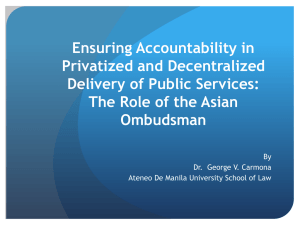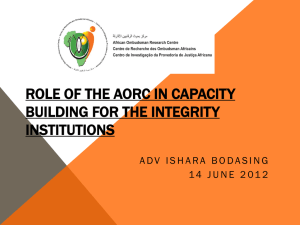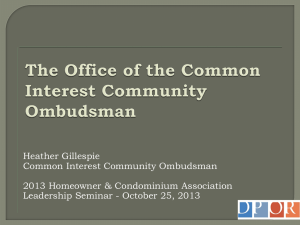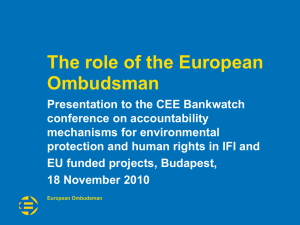fair and reasonable or an affront to the rule of law?
advertisement
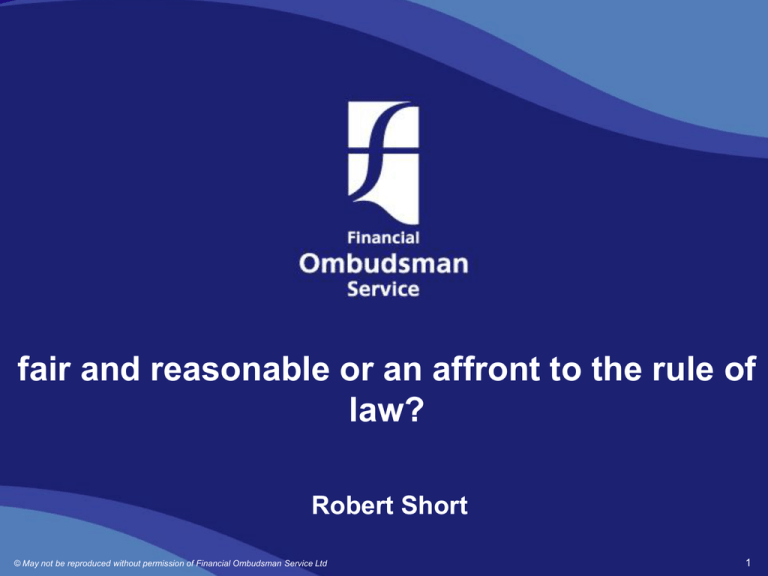
fair and reasonable or an affront to the rule of law? Robert Short © May not be reproduced without permission of Financial Ombudsman Service Ltd 1 agenda the Financial Ombudsman Service – the history alternative dispute resolution the ombudsman way ‘fair and reasonable’ vs. the law fair and reasonable – what does it mean? case studies ombudsman ‘lore’ conclusion © May not be reproduced without permission of Financial Ombudsman Service Ltd 2 the history 31 years of being different… 1981 Insurance Ombudsman Bureau 3 insurers membership by agreement 2001 Financial Ombudsman Service whole financial services industry set up by law © May not be reproduced without permission of Financial Ombudsman Service Ltd 3 ombudsman’s ADR unlike the courts the Service… is inquisitorial – we ask questions is informal – no pleadings like a court offers ‘bespoke’ redress, and… is ‘fair and reasonable’ © May not be reproduced without permission of Financial Ombudsman Service Ltd 4 fair and reasonable vs. the law a barrister’s view… ‘the Financial Ombudsman Service is quite simply an affront to the rule of law’ Anthony Speaight QC Professional Negligence Bar Association 25 January 2011 © May not be reproduced without permission of Financial Ombudsman Service Ltd 5 fair and reasonable vs. the law but the position at law… ‘a complaint is to be determined by reference to what is, in the opinion of the ombudsman, fair and reasonable in all the circumstances of the case’ Financial Services and Markets Act 2000 s228 (2) © May not be reproduced without permission of Financial Ombudsman Service Ltd 6 fair and reasonable vs. the law and the rules state… ‘the ombudsman will determine a complaint by reference to what is, in his opinion, fair and reasonable in all the circumstances of the case’ – DISP 3.6.1 ‘taking into account (1) relevant (a) law and regulations (b) regulator’s rules, guidance and standards (c) codes of practice; and (2) (where appropriate) what he considers to have been good industry practice at the relevant time’ – DISP 3.6.4 © May not be reproduced without permission of Financial Ombudsman Service Ltd 7 fair and reasonable in practice ask what’s the position in law? what do you think really happened? is the law too harsh in these circumstances? remember every case is unique and dealt with on its own facts and circumstances there are many shades of grey © May not be reproduced without permission of Financial Ombudsman Service Ltd 8 is fair and reasonable at odds with the law? Consumer Insurance (Disclosure and Representations) Act 2012 adopts the ombudsman’s long-standing approach to nondisclosure signals a move away from the Marine Insurance Act 1906, which was considered too harsh for consumers the law will now follow a more fair and reasonable approach Our approach has © May not be reproduced without permission of Financial Ombudsman Service Ltd 9 examples of our fair and reasonable approach matching sets breach of a warranty or condition (Law Commission proposals) non-disclosure damage that has happened gradually pre-existing medical conditions (pet and PPI) damage occurring over 2 separate policy terms with different insurers © May not be reproduced without permission of Financial Ombudsman Service Ltd 10 conclusion how to reach a fair and reasonable outcome remember that the circumstances are rarely clear cut insurance policies can be complicated people don’t have a lot of financial knowledge and can make mistakes – they aren’t all trying to defraud try to be objective consider all of the evidence and information available look for the reasons behind a policyholder’s actions © May not be reproduced without permission of Financial Ombudsman Service Ltd 11 ombudsman ‘lore’ helping you know our approach technical advice desk - 020 7964 1400 online technical resource ombudsman news our website consumer enquiries - 0800 023 4567 or 0300 123 9 123 © May not be reproduced without permission of Financial Ombudsman Service Ltd 12 case studies one a policyholder leaves their keys in their car, with the engine running to de-ice their windscreen. Whilst they are inside their house the car is stolen their policy contains a ‘keys in car’ exclusion the insurer rejects the claim what would the Financial Ombudsman Service want to know to reach a fair and reasonable outcome? © May not be reproduced without permission of Financial Ombudsman Service Ltd 13 case studies one where was the car parked? – driveway/on the road/garage where was the policyholder in the house? – upstairs/front door/by the window what is the area like? –built up/rural/long driveway why did the policyholder go back into the house? – to keep warm/something urgent how was the policy sold? – was the exclusion brought to the policyholder’s attention similar to the court’s approach in Starfire Diamonds © May not be reproduced without permission of Financial Ombudsman Service Ltd 14 case studies two the policyholder makes a claim after their bag is stolen from a Paris railway station when the policyholder returns to England they report the claim to their insurer the policy excludes claims where there is no police report the insurer rejects the claim what would the Financial Ombudsman Service want to know to reach a fair and reasonable outcome? © May not be reproduced without permission of Financial Ombudsman Service Ltd 15 case studies two on what day of the holiday did the theft take place? – first day/last day why isn’t there a police report? – never reported/report not received yet/police chose not to file a report if the theft wasn’t reported, why not? – had to catch a train/couldn’t be bothered/worried about language barriers/police station wasn’t open © May not be reproduced without permission of Financial Ombudsman Service Ltd 16 case studies three the policyholder submits a claim after their car is stolen and found damaged and abandoned there is no sign of forced entry and the insurer suspects the policyholder’s son of taking the car without consent the policy contains an exclusion for loss or damage if a theft is perpetrated by a member of the policyholder’s family the insurer rejects the claim what would the Financial Ombudsman Service want to know to reach a fair and reasonable outcome? © May not be reproduced without permission of Financial Ombudsman Service Ltd 17 case studies three is there an exception to the exclusion whereby the exclusion will not apply if the policyholder co-operates with the police? if there is and there was no prosecution – whose decision was this and did the policyholder co-operate with the police? if not, was the more limiting exclusion brought to the policyholder’s attention? does the son have a known history of TWOC/theft – relevant to prejudice if the exclusion was not highlighted? © May not be reproduced without permission of Financial Ombudsman Service Ltd 18 case studies four a policyholder makes a claim after their home is burgled whilst they were asleep their policy requires them to (warrants they) engage all locks on any external doors at night the policyholder’s front door has a latch-lock and a 5 lever MDL, but only the latch-lock was engaged entry was through the front door and the police conclude the burglar would not have got in if the 5 lever MDL had been engaged the insurer rejects the claim for breach of warranty what would the Financial Ombudsman Service want to know to reach a fair and reasonable outcome? © May not be reproduced without permission of Financial Ombudsman Service Ltd 19 case studies four whether the policyholder was made aware of the warranty whether the policyholder got a discount for having a 5 lever MDL what the insurer would have done about the claim if the consumer had only had a latch-lock on the door © May not be reproduced without permission of Financial Ombudsman Service Ltd 20 case studies five a policyholder submits a claim to their insurer following accidental damage to two tiles on their bathroom floor the insurer is unable to source the exact same make of tile and offers a cash settlement representing the cost of two similar replacement tiles the policyholder is unhappy because they do not believe it is possible to buy similar tiles and the tiles they can buy will clearly not match; they believe the insurer should be liable to cover the entire cost of a new floor the insurer refuses to alter its offer what would the Financial Ombudsman Service want to know to reach a fair and reasonable outcome? © May not be reproduced without permission of Financial Ombudsman Service Ltd 21 case studies five the applicable principle is matching sets (insurer will pay for 100% of the damaged tiles and 50% of the undamaged tiles) can the exact tiles be sourced from somewhere other than the insurer’s usual suppliers? can matching tiles be specially made? if exact replacement tiles cannot be sourced how similar is the nearest match? – is it reasonable for the policyholder to demand that the entire floor be replaced? is it more cost effective to replace the entire floor rather than sourcing two exact replacement tiles? © May not be reproduced without permission of Financial Ombudsman Service Ltd 22 questions © May not be reproduced without permission of Financial Ombudsman Service Ltd 23
